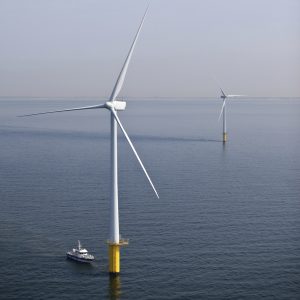High-tech Wind Farm Simulation Awaits Monhegan Island Tourists
 When tourists visit Monhegan Island this summer, they may get a trip to the virtual future.
When tourists visit Monhegan Island this summer, they may get a trip to the virtual future.
Armed with digital tablets and headphones, a group of UMaine student researchers will offer willing participants a chance to immerse themselves in the sights and sounds of a scenario that could impact their experience of the island: the proposed offshore wind farm. Using an experiential technology known as “augmented reality”, researchers will offer tourists a glimpse and an earful of what could be “actual reality” in the near future.
“People aren’t good at taking a 2D image and pulling it into their 3D world. It’s just not something we do well, though we may think we can. Using this technology, we can put people into the environment on Monhegan Island. We can model all the physics of the real world, including sound” said Nicholas A. Giudice, Associate Professor in the School of Computing and Information Science, the project’s principal investigator and leader of the technology development team.
With a grant from UMaine’s Sustainability Solutions Initiative (SSI), a program of the Senator George J. Mitchell Center, Giudice, and a team of faculty and student researchers will use the technology to garner opinions on the two-turbine Maine Aqua Ventus project proposed for an area about two miles off Monhegan. Participants will be interviewed before and after the high-tech encounter to measure its impact. The research is being funded by SSI’s Emerging Opportunities – Foundations for Future Research grant program. Focused on broadening the scope of SSI, these projects offer researchers a chance to engage new stakeholders in new places in new ways.
The goal of the Mohegan Island project is to give tourists – among the most important stakeholders connected to the island – a chance to wrap their minds around the possible effects of an offshore wind farm for the first time. Based on the experience, they’ll be asked to rate the likelihood of their return to the island if the project is completed
Though details of the augmented reality experience are still being refined, here’s how it’s expected to work: participating tourists will be shown a two-dimensional rendering of the wind turbines and their thoughts will be recorded. Then they will be outfitted with stereo headphones and given a digital tablet. The tablet works a bit like a camera. Tourists will be asked to look at certain areas on the island that have been digitally mapped and programed to reflect the effects of the proposed wind farm. So, while it might be a clear day with nothing but the rush of crashing surf in earshot, the outfitted tourist may hear the low-frequency noise of rotating turbines. They’ll also be able to see the turbines in the distance. The 550-feet-plus giants look tiny from the Mohegan shore.
“The goal is to make this as realistic an experience as possible, using real data models, to immerse people into a alternative Monhegan with offshore wind turbines offshore.” said Rick Corey, Director of Operations for the Virtual Environment and Multimodal Interaction (VEMI) Lab.
Mario Teisl and Caroline Noblet, Professor and Assistant Professor in the School of Economics (SOE), will lead the group conducting the surveys and administering the technology on site. Undergraduate researchers will approach people exiting the ferry onto the island. The process is expected to take about 10 minutes beginning with a preliminary questionnaire that covers numerous topics: views on wind power, the prospect of lower electricity costs for island residents and expectations regarding the visual and auditory impacts of the turbines. After the augmented reality experience, participants will answer the questions again to see if their views have changed.
“We know that changes to viewscapes and noise matter to people; so, to correctly measure people’s reactions we need for them to see it and hear it correctly. That is what the technology allows us to do,” Noblet said.
The team will share results with the Monhegan Island Wind Working Group, which represents tourist-based business owners, assessors, power district representatives, commercial fisherman and residents. Researchers will work with the group to write a final report for Monhegan residents.
The research is supported by National Science Foundation award EPS-0904155 to Maine EPSCoR at the University of Maine.
A venture of University of Maine called Maine Aqua Ventus I, the proposed wind energy project is a two-turbine, 12 megawatt floating deep water offshore wind energy pilot project. Aqua Ventus is a consortium that includes Emera, Cianbro Corp., a Maine contractor, and Maine Prime Technologies LLC, a spinoff company representing the University of Maine.
- See more about this project: Using Immersive Virtual Reality to Understand the Impacts of Wind Energy Siting
- See journal article: What drives general acceptance of offshore wind farms? European Commission – Science for Env. Policy, July 10, 2014
